 |
Home > Pavilion > Ride/Show Technology > Traveling Theater

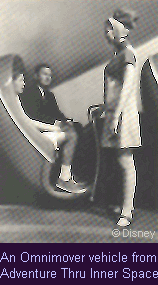 Disney Imagineers have always sought new ways to expand their range of storytelling. Perhaps the most notable
before EPCOT Center was their invention of the Omnimover, which debuted in Disneyland's Adventure Thru Inner
Space. Continuous-loop ride systems had existed before (such as in the '64/'65 World's Fair), but the Omnimover
was a substantial evolution, both in terms of technology and its usefulness in conveying a story. The Omnimover's
ability to rotate and even tilt the ride vehicles meant that attractions could be laid out like movies.
Imagineers could direct the guests' attention to a scene, while limiting their vision beyond that scene. The
Omnimover served Disney attractions well for many decades, in such favorites as the Haunted Mansion and If You Had
Wings. It even made a huge impact on EPCOT, appearing in Spaceship Earth, Horizons, World of Motion, Journey
Into Imagination, and The Living Seas.
Disney Imagineers have always sought new ways to expand their range of storytelling. Perhaps the most notable
before EPCOT Center was their invention of the Omnimover, which debuted in Disneyland's Adventure Thru Inner
Space. Continuous-loop ride systems had existed before (such as in the '64/'65 World's Fair), but the Omnimover
was a substantial evolution, both in terms of technology and its usefulness in conveying a story. The Omnimover's
ability to rotate and even tilt the ride vehicles meant that attractions could be laid out like movies.
Imagineers could direct the guests' attention to a scene, while limiting their vision beyond that scene. The
Omnimover served Disney attractions well for many decades, in such favorites as the Haunted Mansion and If You Had
Wings. It even made a huge impact on EPCOT, appearing in Spaceship Earth, Horizons, World of Motion, Journey
Into Imagination, and The Living Seas.
It seems Universe of Energy almost became Omnimover-based as well. Early renderings for a "Solar Energy Pavilion"
(which later became Universe of Energy) showed guests boarding what appeared to be an Omnimover. Somewhere
along the way though, the concept changed, and called for yet another quantum leap in technology and storytelling.
Enter, the Traveling Theater.
The Traveling Theater might well have its origins in the "Moving Grandstands" in the '64/'65 World's Fair's
"The American Journey". But like the Omnimover, it would be a quantum leap beyond its predecessors. It allowed
for combining different types of experiences--film, live-action, and special effects--in a way that had never
been done before in a Disney attraction.



6-Packs
The Traveling Theater consists of two sets of 6 vehicles plus a spare, for 13 vehicles total. Two groups of more
than 500 guests each, may experience the attraction at the same time. The two sets of vehicles are spaced such
that guests in one set are never aware of the others.
When guests first enter Theater 1, the Traveling Theater is in "6-Pack" formation, with all 6 vehicles clustered
into a theater-seating configuration. Once in the Diorama, the vehicles break into single-file. At the end of
the Diorama, the vehicles file one-by-one back into Theater II, reconstituting the "6-Pack". Finally, they
return to Theater 1 (still in 6-Pack) for the finale.
Though the ride is designed to run on two 6-Packs, in the event that a vehicle breaks down and cannot be serviced
right away, and the spare is also out of operation, the ride can run on one or even two "5-Packs". The disabled vehicles
are taken to the maintenance bay for repair, leaving an open space in the cluster of
vehicles. Due to technical and operational considerations, that open space can be allowed only in "Position 3", where the
front/center vehicle normally resides. If necessary, the remaining vehicles are shuffled around such that the empty space is left in
Position 3. The Ride Control Computer (RCC) is programmed with the new vehicle arrangement, and the show goes on.
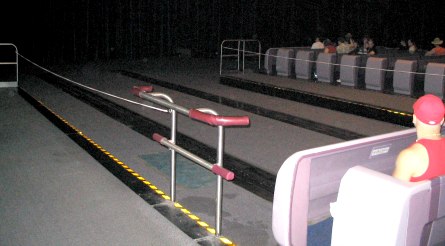

It can be a bit jarring the first time you see a 5-Pack. What's perhaps more odd, even eerie, is to see how the
Travelling Theater behaves in 5-Pack. When peeling off into single-file in the diorama, the timing and spacing are
exactly the same as in 6-Pack. There's a vehicle-sized gap and a long pause before Position 4 moves, as though the
"ghost" of Position 3 is travelling through the diorama.
If more than three vehicles (including the spare) are out of service, the ride is declared "101" until at least one can be repaired. The RCC will
not accept less than 5 vehicles out of each 6-Pack to be in operation. Fortunately, this has never happened in our experience.
Even running two 5-Packs is quite a rarity.

Look Ma, No Track!
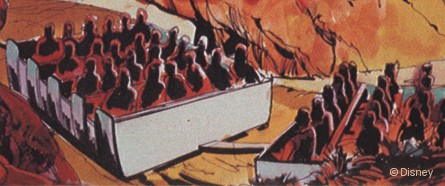

Early artist's renderings show what appears to be the evolution from Omnimover to Traveling Theater.
The vehicles are about a third the size of the Traveling Theeater vehicles we know today, and appear
to be riding on a track. Perhaps at that time they hadn't completely fleshed-out the idea for the
attraction, and hadn't realized that the unique requirements of the ride would make a track-based system
impractical, if not impossible. As we mentioned above, the Traveling Theater starts out in "6-Pack" formation,
where 6 vehicles are clustered into a theater-seating formation. It's ideal for loading, and for viewing
the films in Theater I (and later in Theater II), but to navigate the tight spaces in the Diorama (and to
allow everyone the best possible views), the Traveling Theater would have to go single-file through the Diorama.
If that could even be done with tracks, the "track switches" would be cumbersome and complicated. Aligning
the tracks with the turntables would be yet another complication. What they needed was something that acted
like a track, allowing the vehicles to follow a fixed path, but without the physical constraints of a track.
 They apparently took a cue from GM's "intelligent roadbed" concept (as seen in Horizons' "Magic Highways"
segment). Instead of a physical track, the Traveling Theater would follow of "virtual track", along a buried
"guidewire".
They apparently took a cue from GM's "intelligent roadbed" concept (as seen in Horizons' "Magic Highways"
segment). Instead of a physical track, the Traveling Theater would follow of "virtual track", along a buried
"guidewire".
The trackless guidewire system, which to this day seems pretty amazing, must have seemed like pure science
fiction back in the late 70s, when the park was being designed and built. "Magic Highways"? Posh! But they
had the technology, the need, and perhaps most important the will to push the envelope in order to present
a compelling ride experience. Just as they'd taken continuous-loop ride conveyances one huge step forward with
their invention of the Omnimover, Disney Imagineers yet again saw an opportunity to expand their range of
storytelling in moving attractions. But as with the surprisingly complex Omnimover, it wouldn't be easy!
The concept of the guidewire system is pretty simple. A wire, just an eighth of an inch thick, is embedded in
the floor, in the desired path of the vehicles. The guidewire transmits a low-level "RF" or radio signal
that the vehicle "listens" for. If the vehicles gets too far from the guidewire in one direction or another,
the signal strength drops--just as you start to lose the signal in your car radio or your cell phone, when you
drive too far out of range of the transmitter. If the wire curves to the left, the signal drops off on the
right. The vehicle senses this, and turns left. If the vehicle follows a path where the signal remains
strongest, it's closely following the guidewire, and thus the intended path. Remarkably, the system keeps
the vehicle movement within two inches of the guidewire's path!
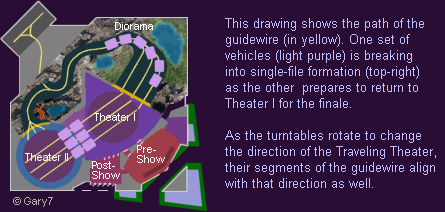
The guidewire could be arranged any way the Imagineers desired. That makes it possible for the vehicles, which
had been travelling side-by-side, to converge into a single line through the diorama.

Electronic Ringmaster
Here's where it starts to get more complicated. A computer would be needed to interpret the signals and carefully
adjust the steering. Each vehicle would have to carry its own on-board computer. Since the vehicles are "autonomous",
with no connection to the rest of the ride system, each would also need its own propulsion (a motor to drive the
vehicle), steering control, and power systems.
With a fleet of autonomous vehicles, ready to follow a guidewire in whatever path it may be laid, we're all set, right?
Not quite. Just as with the "Magic Highway", there would have to be some kind of "central computer" to manage the
traffic of the twelve vehicles, and there would have to be a way for this central computer to communicate with all
the vehicles. Universe of Energy's "Wayside" computer handles vehicle traffic, and in fact oversees all of the ride
system. It coordinates the movement of the vehicles, turntables, show doors; it takes input from the Ride Operator
Consoles; and it synchronizes everything to the show.
To make it possible for the Wayside and the vehicles on-board computers to communicate, the guidewire actually
offers "two-way" communication. A transceiver (transmitter/receiever) on the underside of the vehicle listens not
just for the presence of the guidewire, but also for what it has to say. The Wayside computer transmits through
the guidewire any information that the vehicles may need--including commands to start or stop, the status of the
ride, and so on. The vehicle responds to the wayside, using its transceiver to send a signal through the guidewire.
It tells the wayside roughly where it is, and that it's either operating normally, or has encountered a problem of
some sort. This two-way communication, where the Wayside and the vehicles are constantly updating one another on
their status, is known as "handshaking" or "polling".

Can We Talk?
The Wayside and vehicles, seemingly so silent, are actually a pretty chatty bunch. They "poll" (talk to) one
another 60 times a second! You may have noticed the flickering LEDs on the back of the vehicles. One of the most
rapidly-flickering LEDs, represents the polling interval. When it's flickering, the vehicle and the Wayside are
conversing.
Be glad that these computers like to talk so much, because without this sharing of information, the vehicles
wouldn't know what to do or where to go. Some long-time Cast Members have reported that missing or misunderstood
communications were a problem early on, and that the vehicles would run off on their own: into the consoles,
and even the show scenery! We can't substantiate these stories--and they may well be "urban myth"--but it does
go to show the importance of the Wayside keeping in touch with all the vehicles, and keeping them properly coordinated.
Whether in response to the alleged problems, or perhaps in place from the beginning, there are several
"failsafes" built into the system. If a vehicle stops hearing from the Wayside (perhaps it's veered off
the wire, or there is some other malfunction), the vehicle's on-board computer shuts down the vehicle
immediately. Likewise, if the Wayside stops hearing from a vehicle, it tells all the other vehicles to stop
right where they are. The Wayside can also issue an "E-Stop" (Emergency Stop) to all the vehicles if it
detects a serious problem, or at the command of a Cast Member pressing an E-Stop button or failing to
accept a prompt. Should all of that fail--or if the vehicle runs into an unexpected obstruction in its path--a
pressure-sensitive strip along the vehicle's front bumper will trigger an automatic E-Stop.

Checkpoint
As long as the vehicles are able to report back to the Wayside, it knows that they're still following the wire.
But it doesn't know exactly where the vehicles are. It just knows that they're "out there", somewhere on the
wire. In order to approximate the vehicles' positions, there are checkpoints along the way, known as "benchmarks."
These benchmarks can be found on the Turntables, in the diorama holding area (where the vehicles settle for a
moment in "6-Pack" formation, before breaking into single-file), and at several points along the path of the
Diorama. The benchmarks consist of magnets embedded in the floor, which trigger a sensor on the underside of
the vehicles. When a vehicle detects a benchmark, it signals back to the Wayside. The Wayside knows how long
it should take each vehicle to reach a particular benchmark, so if it's late reporting back, it knows something
is wrong, and issues an E-Stop to all of the vehicles.
The benchmarks are also used for precisely "parking" the vehicles on the turntables and in the Diorama holding
area. When the vehicles reach these benchmarks, they stop and apply their brakes--parking in just the right spot.

Charge It!
The last remaining piece of the puzzle is--ironically enough--energy! The vehicles have their own power systems,
which are based on eight car batteries. But as you probably know, car batteries have to be frequently recharged,
or they drain down quickly. How they do it is quite clever, and a story unto itself, which we invite you to read
in Charging System.

Glide Path
You may have seen long metal strips on the floor, disappearing beneath the vehicles. Many guests have
mistaken these for "tracks", but as we've seen, the Traveling Theater doesn't ride on a track. So why
the metal strips? They are "wheel guides", which allow the vehicles' wheels to gain greater traction on the carpet.
They likely also reduce the build-up of static charges. Early on, the static buildup from the vehicles
riding across the carpet became quite a problem, wreaking havoc with the vehicles' on-board electronics. Once
the Maintenance crew isolated the problem, they installed brushes to collect and dissipate the charges.
While that apparently did the trick, they may have found it prudent to eliminate the source of the static as well.
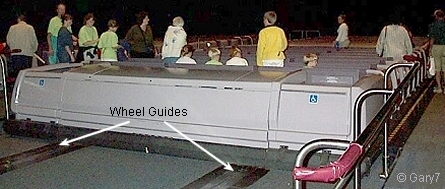


Energy Goes Wireless
Sometime after year 2000, Energy's original guidewire system was replaced with something functionally equivalent,
but based on a different (presumably more advanced) technology. The system uses sensors that have been described
as "Pucks" (apparently for their shape) spaced along the ride path. If anyone has additional details on how this
system works, please email us, we'd like to know more about it!

Traveling Beyond Energy
The Traveling Theater and its "trackless" guidance system opened up new possibilities for several other attractions,
following its debut in Universe of Energy. The first attraction after Energy to benefit from this technology was Disney-MGM
Studios' Great Movie Ride. The vehicles were smaller, and were operated by a live Cast Member, but as with the
Traveling Theater, they followed a guidewire. As we understand, the guidewire system at Great Movie Ride has since been
replaced by the "puck" system as well.
Perhaps the most clever and effective use of this technology to date (reportedly also a puck system) is the "Fifth
Dimension" scene in the Twilight Zone Tower of Terror. We won't mention how it's used, as we don't want to spoil a
very stunning and effective twist!
Finally, there is The Many Adventures of Winnie the Pooh in Tokyo Disneyland. Reports on this system are particulary
sketchy--it may be a puck-based system, or yet another type of "trackless" system. In one scene, the "Honey Pot" vehicles
virtually "dance" through a room, in an effect that some have described as "breathtaking" and "magical."


Related Pages
Driving Vehicles (REPO)
What do you do when the Wayside computer won't direct the vehicles? You drive them yourself! It's
a fascinating, if somewhat surreal experience.
Charging System
Learn about Universe of Energy's "Inductive Power Coupling System", which transmits energy to the
vehicles through thin air!
Atommobiles.com*
View a stunning tribute to the attraction that brought us the Omnimover, Adventure Thru Inner Space.
NYWF64.com*
Learn more "Moving Grandstands" used in the 64/65 World Fair's "The American Experience".
Note: Links above marked with an asterisk *,
link outside this site. They will open in a new window, so you do not lose your place here.


Special Thanks
We'd like to offer a special "thank you" to those who helped with information and/or photos for this
page (in alphabetical order):
- Bill from NYWF64.com* for the photo and information on the Moving Grandstands (photos © 1964, Elevator World Magazine)
- Dean for "connecting the dots" between the Moving Grandstand and the Traveling Theater
- Dr. Lao for information on the Solar Energy pavilion.
- Kirby Bartlett-Sloan for the "Magic Highways" photo.
- Rob for the information on the guidewire's replacement.
- Steve from Atommobiles.com* for the Atomobile photo.
For additional credits and information, visit our Credits page.

|
 |
|
|





